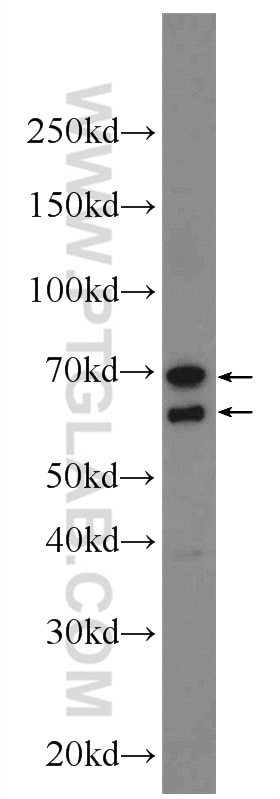LCTL Polyklonaler Antikörper
LCTL Polyklonal Antikörper für IF, WB, ELISA
Wirt / Isotyp
Kaninchen / IgG
Getestete Reaktivität
human
Anwendung
WB, IF, ELISA
Konjugation
Unkonjugiert
Kat-Nr. : 24589-1-AP
Synonyme
Galerie der Validierungsdaten
Geprüfte Anwendungen
| Erfolgreiche Detektion in WB | MCF-7-Zellen |
| Erfolgreiche Detektion in IF | HeLa-Zellen |
Empfohlene Verdünnung
| Anwendung | Verdünnung |
|---|---|
| Western Blot (WB) | WB : 1:500-1:2000 |
| Immunfluoreszenz (IF) | IF : 1:10-1:100 |
| It is recommended that this reagent should be titrated in each testing system to obtain optimal results. | |
| Sample-dependent, check data in validation data gallery | |
Produktinformation
24589-1-AP bindet in WB, IF, ELISA LCTL und zeigt Reaktivität mit human
| Getestete Reaktivität | human |
| Wirt / Isotyp | Kaninchen / IgG |
| Klonalität | Polyklonal |
| Typ | Antikörper |
| Immunogen | LCTL fusion protein Ag20220 |
| Vollständiger Name | lactase-like |
| Berechnetes Molekulargewicht | 567 aa, 65 kDa |
| Beobachtetes Molekulargewicht | 39 kDa, 65 kDa, 70 kDa |
| GenBank-Zugangsnummer | BC152990 |
| Gene symbol | LCTL |
| Gene ID (NCBI) | 197021 |
| Konjugation | Unkonjugiert |
| Form | Liquid |
| Reinigungsmethode | Antigen-Affinitätsreinigung |
| Lagerungspuffer | PBS mit 0.02% Natriumazid und 50% Glycerin pH 7.3. |
| Lagerungsbedingungen | Bei -20°C lagern. Nach dem Versand ein Jahr lang stabil Aliquotieren ist bei -20oC Lagerung nicht notwendig. 20ul Größen enthalten 0,1% BSA. |
Hintergrundinformationen
Lactase-like is a glycosidase enzyme, which could hydrolyze glycosidic bonds and are classified into families based on primary amino acid sequence. The mouse ortholog of this protein has been characterized and has a domain structure of an N-terminal signal peptide, glycosidase domain, transmembrane domain, and a short cytoplasmic tail.
Protokolle
| Produktspezifische Protokolle | |
|---|---|
| WB protocol for LCTL antibody 24589-1-AP | Protokoll herunterladen |
| IF protocol for LCTL antibody 24589-1-AP | Protokoll herunterladen |
| Standard-Protokolle | |
|---|---|
| Klicken Sie hier, um unsere Standardprotokolle anzuzeigen |



